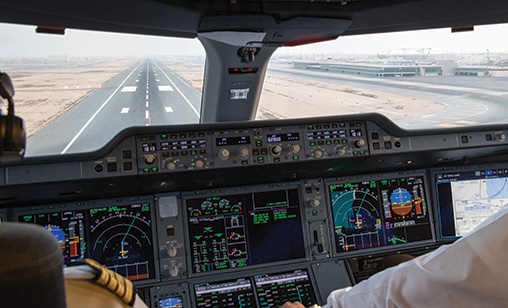News Backgrounder
Entering the era of fewer pilots in the long haul cockpit
September 1st 2018
Forecast demand for pilots in the Asia-Pacific to 2037 declined by five per cent, to 240,000 cockpit crew, said Boeing in its latest annual Boeing Pilot and Technician Outlook released last month. Read More »
The report said the region would account for 33% of demand for pilots as Asia-Pacific carriers expanded their fleets to 40% of airliners worldwide by 2037. Global demand by 2037 would be 635,000 commercial airline pilots. China alone would require 128,500 new pilots in the next two decades.
 |
Airbus and Boeing differ in their forecasts of the make-up of the future global fleet. Boeing said it would be 42,730 jets. Airbus predicted a 37,400 global aircraft fleet. Variations aside, the numbers are huge and training academies are expanding, especially in the Asia-Pacific, to accommodate airline growth.
At the Farnborough Air Show in July experts said expanding crew training facilities worldwide may only be part of the answer to crewing aircraft in future decades.
Artificial intelligence (AI) could allow big jets to be flown by fewer pilots, particularly on long haul flights, said Airbus and Thales. The European manufacturers said AI was “a fertile avenue of exploration”. They said crews of three or four pilots on long routes could be reduced to two by 2023 because technology would reduce cockpit workloads.
“That’s not an absurd date. Reducing crew on long-range looks to be the most accessible step,” Airbus head of engineering, Jean-Brice Dumont, said at a media briefing at the UK air show.
At Boeing, it is understood its engineers are examining the option of reduced manning for the cockpit of the proposed midsized aircraft (MDA), a plane that could be in service by 2025. Boeing has made no decision about an MDA program.
Options included embedding of AI in cockpits, airborne connectivity that would allow for decision-making on the ground and replacement of current cockpit instruments with digital interfaces. Longer term, a fully autonomous commercial jet, developed along the lines of the driverless car, may be a reality by 2040, Thales said.
Cockpit crew cutbacks would most likely begin with cargo flights but for the aerospace architects of the world, it is progress. In the 1980s, cockpit crew numbers were reduced from three to two as new generation jets eliminated the need for flight engineers. Financial services group UBS said that a one pilot cockpit could save airlines $15 billion a year. From a passenger perspective, this is a most unwelcome outcome. A UBS poll revealed only 13 percent of respondents would board a jet flown with a single pilot.
There are other issues to overcome when re-engineering cockpit manning. There are safety reasons for having more than two pilots in the cockpit on long-haul flights and at least two on shorter journeys. The costs outweigh benefits, argue sceptics of the one pilot aircraft.
If it is assume new technology will make reduced cockpit crew manning inevitable, the biggest hurdle to this operating outlier would be regulatory. Convincing regulators of the safety of such a radical departure from past operating axioms as well as achieving certification for the change would take longer than the development of the one pilot cockpit.
Dumont said the single pilot operation is not an absolute must. “It may be necessary because of the disparity between the number of aircraft entering fleets and number of pilots needed to fly them,” he said.
The pilot squeeze has shown up most recently in India where the government has been forced to extend the deadline for phasing out foreign pilots at the nation’s carriers from December this year to December 31, 2020 because of a shortage of up to 250 pilots. It is estimated that Indian airlines, which have more than 1,100 airliners on order, will need 10,00 new pilots to fly the expanded national fleet.
Separately, the Qantas Group announced last month that it would build two rather than one pilot training schools in regional Australia with location of the first facility to be announced in weeks.